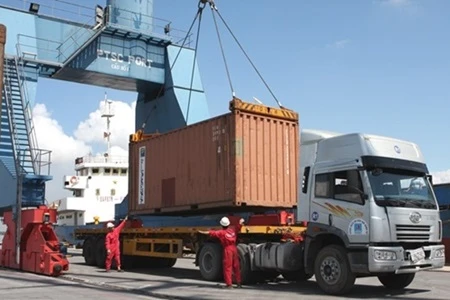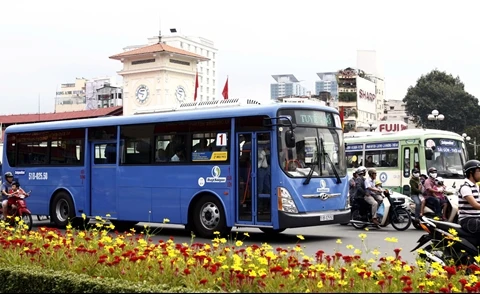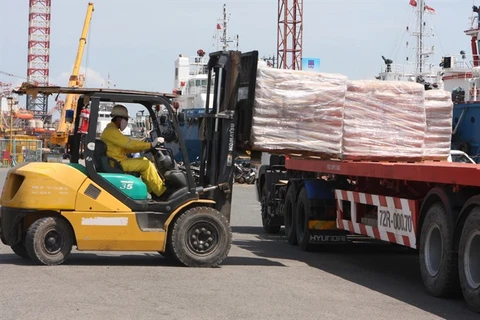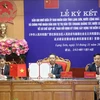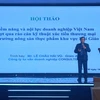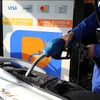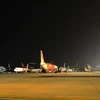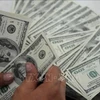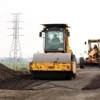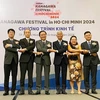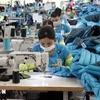Hanoi (VNA) – The decline of the railway’s popularity in Vietnam is not new: back in 2010, the European Union labelled rail transport as the country’s “least relevant” mode of transport.
The issue was recently brought into sharp focus after Transport Minister Truong Quang Nghia claimed the booming air transport industry had "scooped up" all the customers of other modes of transportation, especially of the railway.
However, the reason that rail use lags behind other forms of transportation in Vietnam has more to do with weak infrastructure of the rail system, high overhead, expensive fares and loss of competitive edge.
Dao Thanh Nga from Thanh Hoa central province worked as an accountant in Hanoi and had to travel regularly to Dong Hoi City in Quang Binh central province – her husband’s hometown.
In the past she used the train because of its safety, given that travel time was the same as road transportation, taking about 11-12 hours.
“In train stations, direction signs have been erected, carriage entrances and exits are on the same level as the station, making things easier. (Trains offer) clean beds, helpful staff, nice food catering services, and on-time departures and arrival. The whole journey takes nine and a-half hours. Train travel has really improved, shedding its ‘outdated’ clothes,” Nga told VietnamPlus e-newspaper.
However, those improvements are not sufficient to keep customers like Nga, who now prefers affordable flights that offer the same service quality but shorter travel time: flight plus airport procedures take just under four hours, she said.
“Airlines frequently offer low-cost deals. Sometimes, the total price for a round-trip stands at just about 1 million VND (44.2 USD). Meanwhile, a train ticket with air-con costs around 400,000 VND, and a ticket for a bed and air-con is priced as high as 800,000 VND. A wise customer will choose to travel by air,” she said.
According to Doan Duy Hoach, Deputy General Director of Vietnam Railways (VR), from 2013, passenger transportation via railways has been in a decline, even on 300 to 500km journeys, which previously rail transport dominated.
There are many reasons for this sad state of affairs.
Uneven investment
Road transport continues to receive the lion’s share of state budgets for development, and the allocation for the railway system pales in comparison.
In 10 years, from 2001 to 2010, the total budget for transport infrastructure was approximately 160 trillion VND (7 billion USD), 88 percent of which went to road transport, while a mere 3 percent was targeted for rail transport.
The dichotomy persists: in the next five years (2011-2015), nearly 90 percent of the colossal 330 trillion VND budget is reserved for road transport, and 3 percent for rail transport.
Hoach said this was the leading reason that rail transport lags behind other modes of transportation, accounting for a meagre 1.14 percent of passengers and 2 percent of transported freight.
According to him, the budget allocation could only meet 60 percent of maintenance requirements for existing infrastructure.
Single tracks accounts for 85 percent of the country’s railway network – an outdated infrastructure that greatly limits speed and capacity, a transport expert said.
“For years, investment for upgrading the railway system has never increased,” Pham Thanh Quang, representative of the Vietnam Railway Transport Economy Association, told the Thanh Nien newspaper (Young People).
Meanwhile, Hoach said rail transport still relied on a system built during the French colonisation. Even with upgrades and regular maintenance, the 100-year-old infrastructure could not help but showed its age and failed to attract private investors.
“Previously, two foreign investors invested in railroad operations, but the outdated infrastructure rendered their businesses futile. Even with five-star trains, their projects fell through,” he added.
He also admitted the main advantage of rail transport, namely safety on long-distance travel, could not make up for the inconvenience that customers had to endure.
Competition
For the time being, rail transport firms have no choice but to compete by providing better services.
VR is implementing renovation projects on existing lines. This includes the trans-Vietnam route which is being upgraded to allow 19-20 pairs of trains to operate per night, reduce travel time from over 30 hours to 26-28 hours; upgrade train stations, coaches and online ticket sales; and strive for on-time arrival and departure (95 percent on-time trips).
Train tickets are also on average cheaper than fares of other transport modes, especially air transport, but might be 5-15 percent higher than road transport, depending on the journey.
“The aim of rail transportation is to cut back on costs, and then lower transport fares down to a level comparable to that of road transport,” Hoach said.
Nguyen Ngoc Dong, Deputy Minister of Transport, said that the government must assume a ‘pivotal role’ in railway infrastructure investment.
The Ministry of Transport has submitted to the Government an investment plan for a north-south railroad that would enable travel at 160-200km/h on a 1.345m double-track to accommodate both freight and passenger transport.
“If we want rail transport to develop, the capital investment structure must be adjusted with a priority for railroad, but this adjustment requires time,” Dong said.
Back in September, Dong told a session of the National Assembly’s Standing Committee discussing the adjustments to the Amended Law on Railway, that if the law was amended, "the State’s role will be managing infrastructure while train services will be ceded to private businesses.”
“In 2017, when transport companies are equitised, business activities are expected to be more robust and proactive to gain back the lost costumers in an increasingly competitive market,” Hoach said firmly. – VNA
The issue was recently brought into sharp focus after Transport Minister Truong Quang Nghia claimed the booming air transport industry had "scooped up" all the customers of other modes of transportation, especially of the railway.
However, the reason that rail use lags behind other forms of transportation in Vietnam has more to do with weak infrastructure of the rail system, high overhead, expensive fares and loss of competitive edge.
Dao Thanh Nga from Thanh Hoa central province worked as an accountant in Hanoi and had to travel regularly to Dong Hoi City in Quang Binh central province – her husband’s hometown.
In the past she used the train because of its safety, given that travel time was the same as road transportation, taking about 11-12 hours.
“In train stations, direction signs have been erected, carriage entrances and exits are on the same level as the station, making things easier. (Trains offer) clean beds, helpful staff, nice food catering services, and on-time departures and arrival. The whole journey takes nine and a-half hours. Train travel has really improved, shedding its ‘outdated’ clothes,” Nga told VietnamPlus e-newspaper.
However, those improvements are not sufficient to keep customers like Nga, who now prefers affordable flights that offer the same service quality but shorter travel time: flight plus airport procedures take just under four hours, she said.
“Airlines frequently offer low-cost deals. Sometimes, the total price for a round-trip stands at just about 1 million VND (44.2 USD). Meanwhile, a train ticket with air-con costs around 400,000 VND, and a ticket for a bed and air-con is priced as high as 800,000 VND. A wise customer will choose to travel by air,” she said.
According to Doan Duy Hoach, Deputy General Director of Vietnam Railways (VR), from 2013, passenger transportation via railways has been in a decline, even on 300 to 500km journeys, which previously rail transport dominated.
There are many reasons for this sad state of affairs.
Uneven investment
Road transport continues to receive the lion’s share of state budgets for development, and the allocation for the railway system pales in comparison.
In 10 years, from 2001 to 2010, the total budget for transport infrastructure was approximately 160 trillion VND (7 billion USD), 88 percent of which went to road transport, while a mere 3 percent was targeted for rail transport.
The dichotomy persists: in the next five years (2011-2015), nearly 90 percent of the colossal 330 trillion VND budget is reserved for road transport, and 3 percent for rail transport.
Hoach said this was the leading reason that rail transport lags behind other modes of transportation, accounting for a meagre 1.14 percent of passengers and 2 percent of transported freight.
According to him, the budget allocation could only meet 60 percent of maintenance requirements for existing infrastructure.
Single tracks accounts for 85 percent of the country’s railway network – an outdated infrastructure that greatly limits speed and capacity, a transport expert said.
“For years, investment for upgrading the railway system has never increased,” Pham Thanh Quang, representative of the Vietnam Railway Transport Economy Association, told the Thanh Nien newspaper (Young People).
Meanwhile, Hoach said rail transport still relied on a system built during the French colonisation. Even with upgrades and regular maintenance, the 100-year-old infrastructure could not help but showed its age and failed to attract private investors.
“Previously, two foreign investors invested in railroad operations, but the outdated infrastructure rendered their businesses futile. Even with five-star trains, their projects fell through,” he added.
He also admitted the main advantage of rail transport, namely safety on long-distance travel, could not make up for the inconvenience that customers had to endure.
Competition
For the time being, rail transport firms have no choice but to compete by providing better services.
VR is implementing renovation projects on existing lines. This includes the trans-Vietnam route which is being upgraded to allow 19-20 pairs of trains to operate per night, reduce travel time from over 30 hours to 26-28 hours; upgrade train stations, coaches and online ticket sales; and strive for on-time arrival and departure (95 percent on-time trips).
Train tickets are also on average cheaper than fares of other transport modes, especially air transport, but might be 5-15 percent higher than road transport, depending on the journey.
“The aim of rail transportation is to cut back on costs, and then lower transport fares down to a level comparable to that of road transport,” Hoach said.
Nguyen Ngoc Dong, Deputy Minister of Transport, said that the government must assume a ‘pivotal role’ in railway infrastructure investment.
The Ministry of Transport has submitted to the Government an investment plan for a north-south railroad that would enable travel at 160-200km/h on a 1.345m double-track to accommodate both freight and passenger transport.
“If we want rail transport to develop, the capital investment structure must be adjusted with a priority for railroad, but this adjustment requires time,” Dong said.
Back in September, Dong told a session of the National Assembly’s Standing Committee discussing the adjustments to the Amended Law on Railway, that if the law was amended, "the State’s role will be managing infrastructure while train services will be ceded to private businesses.”
“In 2017, when transport companies are equitised, business activities are expected to be more robust and proactive to gain back the lost costumers in an increasingly competitive market,” Hoach said firmly. – VNA
VNA

